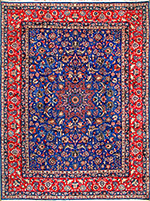Textiles Studies

Textile Research Works
Part One: The "Elements" of Sciences and Crafts
Date of this Version
2008
Document Type
Article
Citation
Iranian Studies, Vol. 41, No. 4, Sciences, Crafts, and the Production of Knowledge: Iran and Eastern Islamic Lands (ca. 184-1153 AH/800-1740 CE) (Sep., 2008), pp. 437-439
Abstract
Among the sciences and crafts of eastern Islamic lands, geometry emerges as a subject that transcends disciplinary boundaries with which we are familiar today. The Elements and Optics of Euclid (ca. 300 BCE), the Conies of Appollonios (third century BCE), and the Mechanics of Heron (first century CE) and Pappus of Alexandria (fourth century CE), highlight the prominence of geometry in the sciences. Apart from the textual tradition and the written transmission of knowl edge, a glance at illustrations and diagrams, scientific instruments, illuminated manuscripts, and monuments of art and architecture reminds us of the signifi cance of geometry in textual and visual traditions alike. The close relationship of visual evidence to textual sources immediately calls into question the contem porary paradigm that segregates sciences from crafts as independent endeavors that are ontologically discrete. Rather, geometry in Arabic and Persian traditions, as well as in the arts and architecture, incontrovertibly links the sciences and crafts in the production of knowledge. Such a unified perspective breaks down contemporary dichotomies by finding expression within both the historical textual tradition and extant monuments. "The 'Elements' of Sciences and Crafts," adopted as the title of the present section, is itself inspired by the historical analogy between the classic Elements (Stoicheia) of Geometry and the letters of the alphabet in a given language. The kinds of interaction that existed, not just between early sciences and crafts, but also among scientists and craftsmen, is a subject that has received recent attention, sparking considerable discussion with reference to "mathemat ics and the arts" and "mathematics and artisans." Primary sources may contribute to a better understanding of the nature of such possible encounters.


Comments
Links to article @ JSTOR